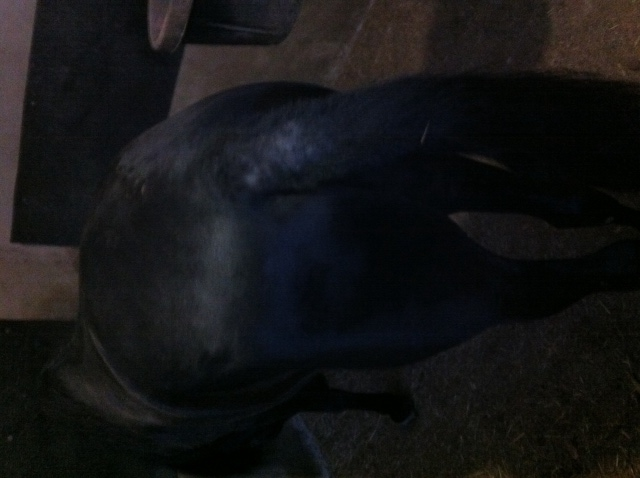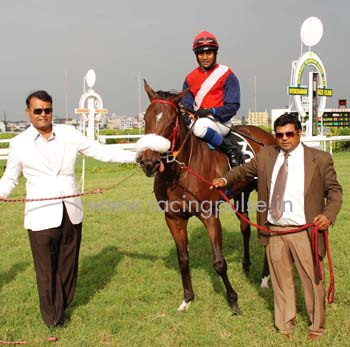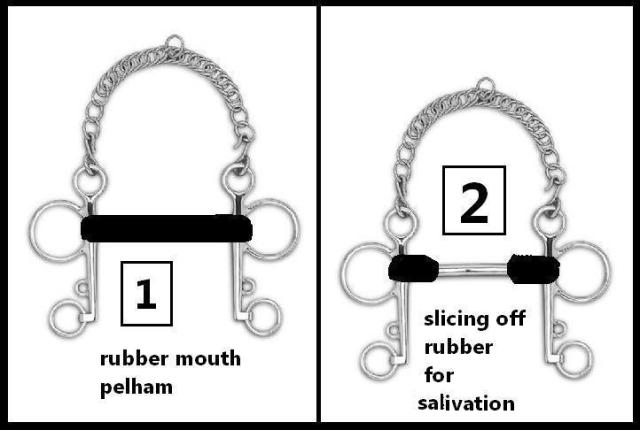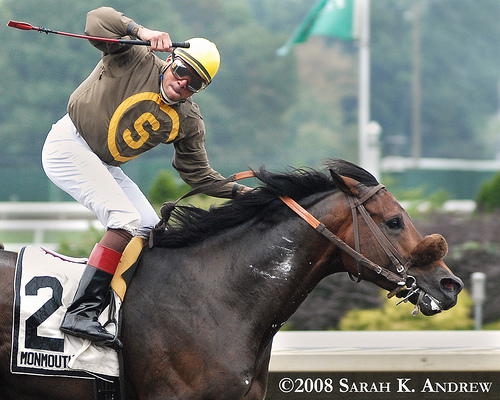QuestionQUESTION: I grew up on a ranch and have riden my whole life. I have recently moved away and have a friend that is interested in having me break her 3 year gelding. Professional training is not an option for her and I dont have a schedule that allows me to work with this horse more than 2 days a week and a couple hours at a time and will be moving again in 8 months, I have only worked with my families horses where we never really used any specific technique, just used a snaffle bit and over time made a transition from plow reining to neck reining. Would there be a certain technique you would suggest I use to get the most out of the little time I have to work with this horse?
ANSWER: Rick Gore: In Natural Horsemanship we don't break horses we start them! :)
Hey Chad, I never start any horse in a snaffle bit. Most trainers start in a halter. Since you are teaching a young horse, he is going to make mistakes, will not understand and will have some resistance. If you start in a bit, you may and probably will hurt the little guy and that will go a long way to set back training and will increase the fear in the horse. You goal should always be to remove fear not create it. Pain = fear, so you don't this.
Don't get in a hurry with this guy due to time. Time means nothing to a horse. Some go faster some slower, he has to go at his own pace. I would do 90% ground work at first, don't get in a hurry to get under saddle. Do lots of changing directions, backing, and really make sure the horse knows how to move before you get on him. He should know walk, trot and canter and should do it very easy without getting excited, before you mount him.
Then do lots of sacking out to remove fear before you attempt saddle. Go to my website and under horsemanship I have a section about sacking out, it will help explain this. Once you get the saddle on and off a few times, let him wear it for an hour or so. don't work him under saddle until he is totally good with wearing a saddle, then round pen with saddle. The fist time is the key to starting horses. The first experience must me good. So to make sure it is good it has to be short. I mean the first time you put the saddle on, remove it. Put it on and take it off. The first time you get in saddle, get off, get on get off. Any blowups will make the horse more scared and will set back your training by three fold. Take it slow and it will be faster.
A good rope halter would be worth the investment. I always do all my ground work in a rope halter and then the first few rides I ride in a rope halter. With just on rope or one rein, you can't ruin and confuse the horse, since you are riding with a lead rope and halter, you only have one rein to use, this sends clear signals and if the horse bucks, you can only pull on one rein. You have to get the horse used to having the lead rope tossed over his head from side to side, so when you ride him and toss it to the other side it will not spook him. I have a Rope halter page on my site if you have never used one before.
Take it slow, remove fear, good consistent cues, never get mean or mad, always end on a good note and many short lessons are better than a few long ones.
Good luck,
Rick
---------- FOLLOW-UP ----------
QUESTION: Thanks, your website really helped, I really agree with your natural horseman style of humane treatment of horses durring training, it really pays off in the end when your horse is obedient out of love and respect instead of fear, a little different from a lot of the local cowboys break em down style I have seen... I was working with him durring my christmas break. He is actually surprisingly well tempered and mellow, very different from any of the young horses I have worked with, I did some ground work with him and took to a sadle and all the gear very well, nothing bothered him. I have used a rope haulter but never in riding and training a young horse, I was a little confused on your technique of directing a young horse while riding with a rope haulter and single rope? would I neck rein or plow rein him? Would it work to use 2 ropes/reins? are you against plow reining with a snaffle bit?
AnswerHey Chad, sounds like the little guy is doing well. A snaffle bit is actually designed to be a direct rein (plow rein) bit. When you flex a horse to left, he actually feels the pressure from the right and he should move away from that pressure. A lot of people pull the head which does not teach the horse to move away from the opposite side pressure. The term plow reins can imply you pull or force the head. I use a boasl (hackamore). It, like the snaffle bit is a direct rein bridle. A bit is a bit bridle and a hack is a bitless bridle. If a person leads a horse correctly and does not pull or yank the horse around, the horse will learn to give to soft pressure from the halter (much like a bitless bridle).
As for riding and starting with a halter. One rein really helps rider and horse. No confusion for either. The rider only has one rein so he cant pull on two reins and confuse the horse. The horse only can get pressure on one side so he learns to give to consistent one side pressure.
When doing your ground work, you should be standing in front of the horse, facing him and swinging the lead rope (with NO buckle so it can't hurt or scare him) like a jump rope. After he is used to the rope swinging and doing circles, then you slowly and softly swing the rope over his head and ears. The horse should stand still and then reverse your swing to unwrap the rope over the head. Then swing it over the head on the other side. It is hard to explain, but imagine the rope is tied to the horse neck. If you swing the rope over the horse it would go over the head, you do the same thing with the rope. So it will only be a half swing over the head and then a half swing back over the head in the other direction. This will get the horse used to having the rope tossed over his ear, nose and head, so when you are in the saddle, this will be nothing new.
As for riding with a rope halter. You mount the horse with the lead rope flexing the horse slightly towards you. After you are in saddle the lead rope will be in left hand and on the left side of the horse. (if you mounted from the left side) With a young and new horse, your right hand will be in the nightlatch/bucking strap. Now the horse should know walk, click or the go/move command. As the horse walks off you really don't want to steer much. Just make sure he will move when you tell him. Then when you stop, you give lots of cues, you stop movement in your hips, drop you seat, lean back, feet move a little forward, say Whoa and slightly take up slack in lead rope. Your goal is to get him to stop without flex or bending is neck, but you may need to do that a little at first. If you have taught him whoa good on the ground, he should stop with little rein pressure. Then while in saddle flip or roll or throw the lead rope to the other side of the head. Now the lead will be on the right side of the horse and in your right hand. Your left hand now goes in nightlatch. If you did this on the ground enough, the horse will not react at all. Then walk and stop with one rein of the other side.
After he has the move and stop down, then you can start on direction. Since you still only have one rein, you can only direct rein on one side for now, later you will be able to completely steer him with one rein. So if the rein is on the left you will work on directing the horse on left turns and left circles. Then flip the rein over the head to the right and work on right turns and circles. After he gets good at this and you get good at using one rein, then you can go to two reins, but you will remember to only use one.
If you are using good body language when using one rein, you will be looking the way you are turning, which will twist your hips in the saddle, you will be giving slight leg pressure with one leg and moving the other leg away/releasing pressure. If you are going left, your left leg should move away from horse and your right leg moves into the horse and puts pressure, almost pushing the horse into the turn. The more cues you give, the easier the horse will respond. In a few days you will see the horse get it and you will need very little rein pressure and the horse will be reading you body and seat position. Then later you will be able to still use one rein and steer the horse either way with body and the rein will only be an additional aid, which is the start of neck reining(indirect reining).
When I get on my horse with a halter and lead I don't flip rope over him, he knows my legs and all I do is lay the rein on his neck and direct him with my legs. This is moving him to being more neck reined, he is only 3, so he has a way to go, but he is doing very well.
A good rider and good horse is like a dance. People watching should be thinking how does that horse know what he wants. Your cues should be so slight that the average person will not see your hands or legs move. Soft hands make soft horses. I see people say my horse is neck reined. I guess because it sounds cool or they read a book that a good horse is neck reined, so they think somehow that if a horse is neck reined they are good. These same people will be fighting pulling on the reins, kicking their horse and yanking on the bit. Hard hands makes a hard horse. Try and dance with this guy, believe me the horse will make you look good, if you give good consistent cues and direct the horse don't correct him.
Hope this cleared this up, if not shoot me another follow up.
Have fun with this and don't get caught up in perfection, good kind treatment will pay off big later. If you are ever asked who taught you how the ride, the correct answer is "The horse" he is the ultimate teacher of the horse.
Have a good New Year,
Rick

 Hair loss
Question
Tail Tail close up
Rick: i have r
Hair loss
Question
Tail Tail close up
Rick: i have r
 leaning on right shoulder after race
Question
leaning on right shoul
hello maam, this
leaning on right shoulder after race
Question
leaning on right shoul
hello maam, this
 slicing off rubber on the central part of mouthpiece irrespective of any bit it is
Question
slicing off rubber on
hello maam, as you said
slicing off rubber on the central part of mouthpiece irrespective of any bit it is
Question
slicing off rubber on
hello maam, as you said
 foamy sweat
Question
foamy sweat
hello maam, is this foamy s
foamy sweat
Question
foamy sweat
hello maam, is this foamy s
 bad stallion
QuestionQUESTION: Hi Im 15 years old and have a beautif
bad stallion
QuestionQUESTION: Hi Im 15 years old and have a beautif